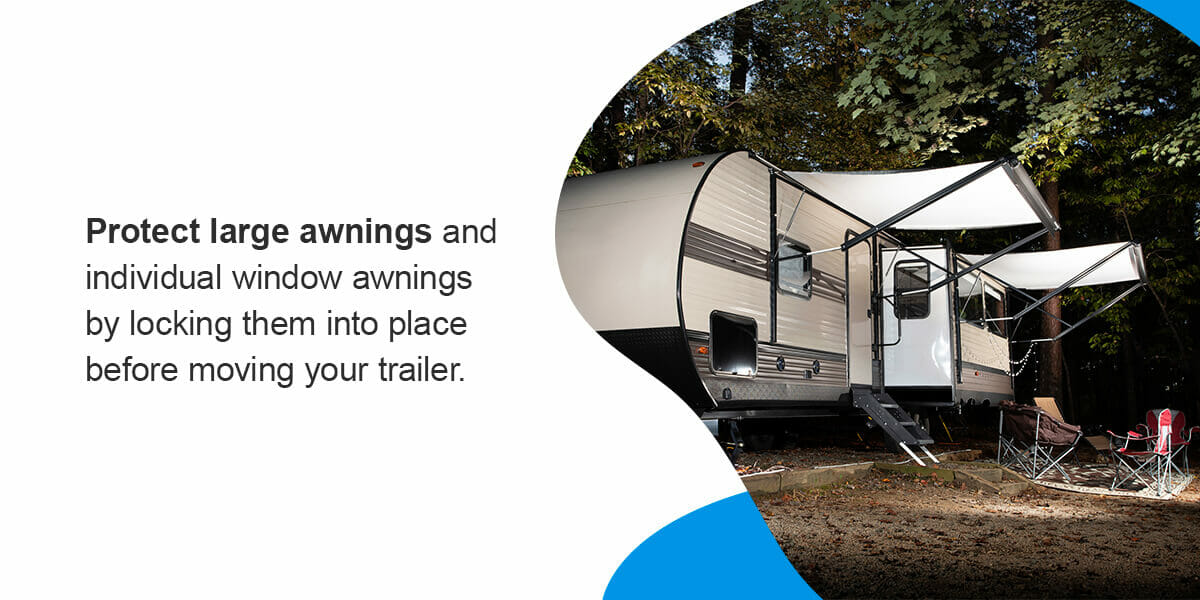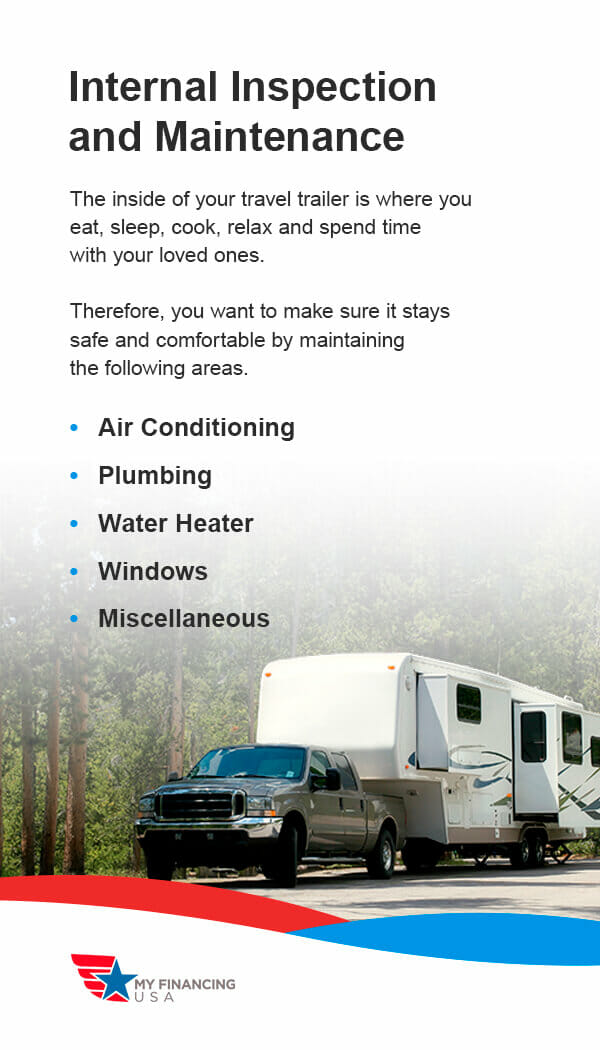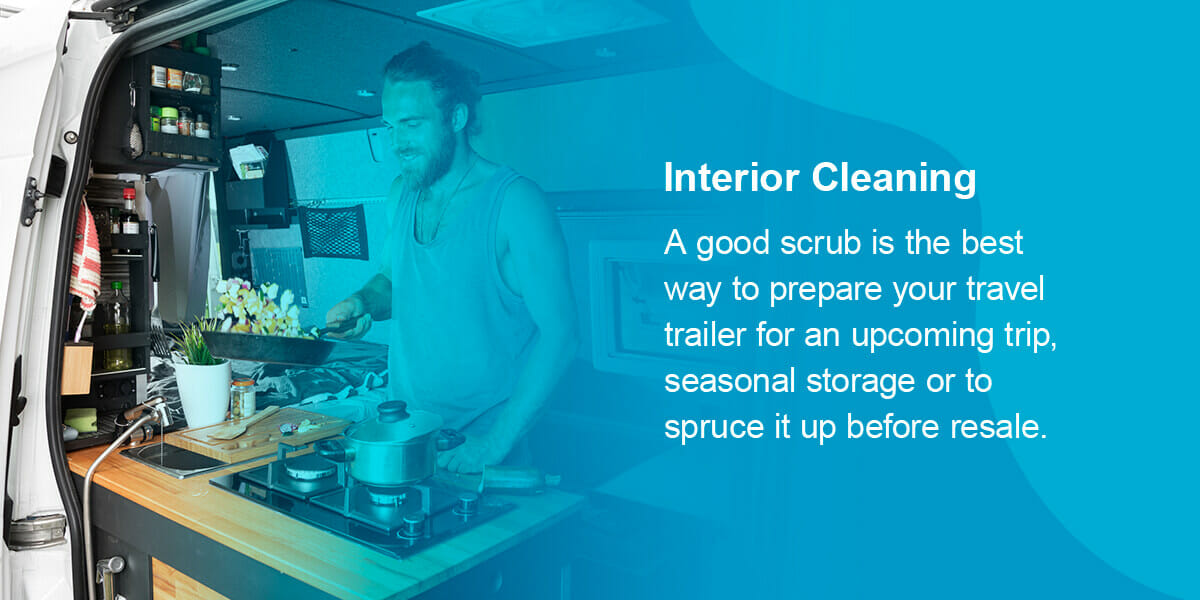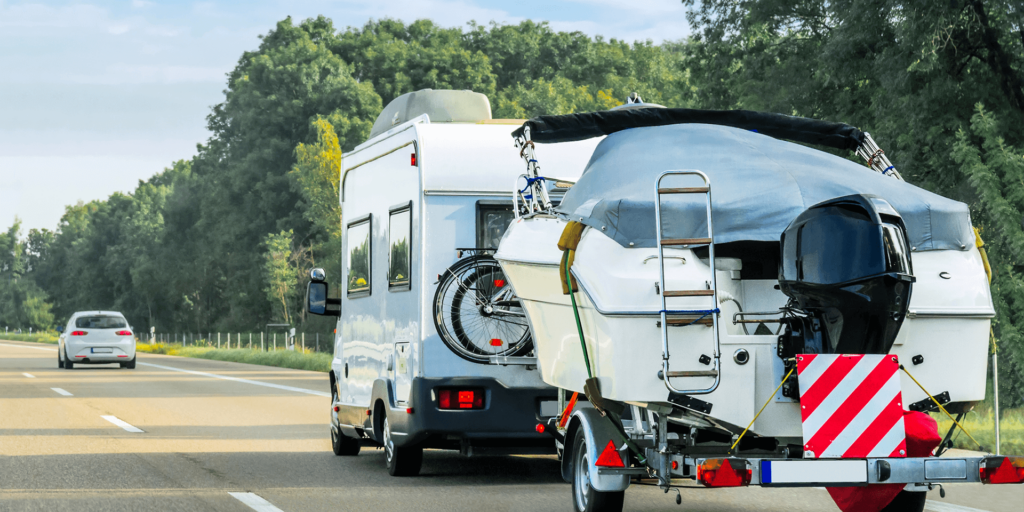Owning a travel trailer gives you the freedom to journey wherever your mood takes you. If you want to ensure your travel trailer is always ready to go, proper maintenance is essential for optimal performance and investment protection. As you use your trailer to travel, its internal and external parts — everything from the water tanks and air conditioning to the carpet and closet doors — inevitably wear down over time.
This travel trailer maintenance checklist will help you maintain your rig so you can enjoy the open road for years to come.
External Inspection and Maintenance
The outside of your trailer comes into direct contact with road debris, sunlight, tree sap and harsh weather, including hail and rain. Check these critical areas to keep your rig dent-free and fully operational:
1. Roof
RV roofs are usually rubber, aluminum or fiberglass. Regardless of your travel trailer's roof, it's important to carefully inspect it before any long trips and after taking it out of seasonal storage. Check all sealants and repair or replace them if you see any signs of cracking, peeling or gapping. These issues can cause damaging moisture leaks or alter the temperature inside your trailer.
Keep roof repair items, like sealant and roof patches, inside your RV for emergency fixes. While you're on the roof, it's also a good time to get a closer look at your roof rack, skylight and vents — reseal and recoat them as needed.
2. Awnings

Protect large awnings and individual window awnings by locking them into place before moving your trailer. Invest in a reliable stabilizing kit to use during high wind or severe storms to minimize the chance of rips and tears. Always allow your awnings plenty of time to air dry before rolling them up, or they could harbor mildew and mold, creating stains and weakening the fabric.
Most camping stores and RV supply centers sell awning cleaners and sealants to maintain water resistance and fight against ultraviolet (UV) fading. Be sure to pick up some RV lubricant for all hardware, including brackets, arm pivots, slide pins and roller tubes. With hardware lubricant, you can move your awning in and out without too much strain or loud noise.
Learn About Travel Trailer Loans
3. Frame and Slideouts
A travel trailer frame includes the exterior walls, undercarriage, stairs, roof and slideouts. Keep all moving elements lubricated and free of rust, corrosion or buildup. Pay especially close attention to gaps around windows, doors and corner moldings when inspecting for damage. Additionally, test your attached stairs for stability, rust damage and retraction. The steps should sit level under the door — if not, use a cement block to keep them sturdy until you can repair them.
The slideouts are either motor-powered with gears or hydraulic with pumps and hoses. Specific care tips vary across models, but you should always ensure no fuses are blown, the battery is charged and all metal parts — leaf springs, rollers, rails, suspension, battery connections and steering parts — are lubricated and rust-free. Invest in a quality slideout treatment to reduce friction and prolong sealants.
4. Brake and Tail Lights
Functioning brake and tail lights keep you safe on the road and are necessary to avoid tickets and legal fines. Make sure all wiring is attached at the connection point and free of any cracks or frayed wires. It's okay to temporarily repair broken connections with electrical tape, but never rely on tape alone as a long-term treatment. Schedule an appointment with a professional to repair electrical connections and lights as needed.
5. Electricity and Propane
The electrical system is crucial for powering your travel trailer when moving and while parked. Make sure the battery is charged, but don't charge it continuously, or you could deplete the electrolyte levels. If the levels get too low, add distilled water until it reaches the split-level mark in each cell — no more and no less. While doing so, check that all cables and terminals are connected and spray with an anti-corrosive to protect the terminal.
Inspect the propane cylinders before every trip and make sure there are no signs of damage, including rust, punctures or gashes. Store any spare tanks in a secure, upright position, somewhere outside of your RV. Turn your propane tank and all valves, ignitors, pilot lights and appliances off while moving or working on them, and stay far away from heat sources. Have a trained professional inspect your propane system at least once annually and after any signs of odor or malfunction.
6. Tires
It's a general rule to change your tires every six to 10 years — unless their printed expiration date lists otherwise — or as needed after punctures or excess tread and wear. Have a professional rotate them periodically. Inspect each tire closely for signs of bulging or cracking. Measure tire pressure with a gauge before each trip and make replacements and repairs as needed. Store spare tires in a cool, dry place.
7. Brakes
Whether they're hydraulic or air assist, your brakes are some of the most critical parts of your trailer. Inspect brake pad thickness, grooves, rotors and drums regularly. Look closely at the brake rims for rust — some rust is normal, but excess rust or corrosion should be taken care of professionally.
Regular brake inspections are essential, especially if you feel like your system is getting too hot or underperforming. In some cases, these issues could just be from worn shoe linings that need a good greasing or a dirty filter cartridge in the air reservoir tanks. Other times, a full replacement is necessary.
8. Miscellaneous
While the following parts aren't quite as critical as those listed above, they each play a role in helping your travel trailer run smoothly:
- Hoses: Store your sewer hoses and freshwater hoses in separate, clean totes away from one another to avoid contamination. Make sure they're completely flushed, cleaned and dried before coiling them. Attach plastic bags to each opening to protect the inside from dust, debris and pest invasion. Secure a zip tie or rope around the coiled hoses to save space, or use a hose reel in your compartment for quick access.
- Compartments: Open all external storage compartments and make any necessary modifications to increase space. Additionally, clean the carpet, check for holes and replace any worn or loose locks.
- Antenna: Crank antennas rely on regular lubrication to move up and down with ease. Occasionally inspect your roof for dirt, sap and leaves that could get stuck around the antenna and keep it from receiving signals or moving.
- Jacks: Keep the jack at the front or back of your travel trailer clean, dry and lubricated. Invest in a protective cover to keep the stand safe from sun fading or temperature-related cracking.
- Hitch: Grease the trailer's ball hitch and coupler regularly to minimize any grinding, and make sure the sway bar is clean and tightened before using. The backup safety chain should always be strong and damage-free — replace it if it feels like it could snap or if it corrodes.
Maintenance and service for your RV are often unexpected and costly. At My Financing USA, we can help protect you from high costs with our cost protection services. With these services, we can help you finance and pay for tire and wheel protection and vehicle service contract and warranty protection.
Internal Inspection and Maintenance

The inside of your travel trailer is where you eat, sleep, cook, relax and spend time with your loved ones. Therefore, you want to make sure it stays safe and comfortable by maintaining the following areas.
1. Air Conditioning
Clogged air conditioning filters can irritate asthmatic RVers, reduce air quality and leave your travel trailer feeling too warm. Change air filters regularly, check them before each trip and make sure nothing obstructs the vents and ducts, like pet hair. If necessary, clean dirty filters with mild detergent and water — just be sure they're completely dry before replacing them. Those who smoke indoors, own pets or cook on the trailer's stove might have to change filters more frequently.
Check the AC vent cover on your trailer's roof and note any signs of wear or damage and remove any leaves, twigs and other debris that could clog airflow.
2. Plumbing
Usually, travel trailers have three tanks — the freshwater tank for bathing, cooking and drinking, the gray water tank for catching all used freshwater and the black water tank for sewage. All of your tanks should be clean and dry before each trip and before storing your trailer.
Use purifying tablets and trailer-safe chemicals to keep the black tank from harboring bacteria or having an odor. The other tanks stay clean far longer, as long as the water doesn't go stagnant — turn on faucets and showers every once in a while to filter and flush the water through the tanks.
3. Water Heater
A water heater either relies on electricity, propane or both, and it requires a professional eye for serious problems or repairs. Maintain it between tune-ups by flushing it to remove any mineral buildup and clearing any clogs or obstructions from the burner tube.
4. Windows
Replace broken windows, especially if you're traveling in extreme temperatures. While minor cracks in trailer windows or the windshield might not seem cause for alarm, they can expand quickly and may interfere with your trailer's insulation, heating and cooling. Consider switching to energy-efficient windows or using solar curtains if you're trying to keep power costs low.
Install new windows with an adequate amount of caulking to avoid leaving any gaps. Don't attach the window to your trailer until the drain holes are facing the bottom. Once installed, add and secure new weather stripping around each window, then around the front and back door. Finally, test important window features, like screen strength, emergency cranks and hinges.
5. Miscellaneous
- Furniture: Keep furniture comfortable and looking great by replacing frames, cushions and fabrics as they age and wear down. Many RV supply stores and hobby shops carry material for refinishing stained or torn trailer cushions. Now is a smart time to inspect other furniture, like table hinges, shelves and hanging rods, and tighten any loose screws or hinges.
- Insulation: Many trailers have insulation underneath the trailer's frame, like foam or RV skirts. Use a flashlight to inspect it for any tears and seal gaps or holes. Replace insulation as needed.
- Lighting: Change old light bulbs and switch to LED lights if you want to reduce battery consumption. Test that each switch slides or flips with ease.
- Doors: Tighten loose doorknobs and make sure each door closes entirely and sits straight — as your rig moves in transit, it's easy for minor misalignment to happen. Use zip ties or specialty latches to keep cabinets and drawers closed while driving.
- Appliances: Test all appliances, including the fridge, microwave and any small appliances you're bringing along with you, and make sure each item works. Some items, like your refrigerator, might need more maintenance than others, especially if frost accumulates easily inside. Defrost it by sitting a container of steaming water inside and make sure to change surrounding filters regularly.
Keeping Your Rig Clean
A clean rig is a happy rig. Keep things spick-and-span with these deep cleaning tips:
Interior Cleaning

A good scrub is the best way to prepare your travel trailer for an upcoming trip, seasonal storage or to spruce it up before resale. Gather RV-specific cleaning items, plus disinfecting wipes, dusters, microfiber cloths, multipurpose cleaner and any cleaning equipment you need, and get to work on these areas:
- Appliances: Use antimicrobial cleansers to get rid of any mold or mildew inside your fridge. Try warm, soapy water for any other areas. Leave an open container of baking soda inside to help absorb odors in between cleans. Depending on the finish, you might also want to get stainless steel polish.
- Furniture: Use fabric and upholstery cleaners or shampooers to freshen up cushions, chairs and couches — be mindful of any specialty fabrics, like leather or vinyl, which might require special care. Use furniture covers and odor-eliminating sprays to keep your furniture looking great in between washes.
- Plumbing: Flush bathroom and kitchen sinks with a solution of baking soda, vinegar and hot water to cut down on build-up and odor. Scrape food off of dishes before washing them in the sink, and use drain screens in each shower and sink to catch debris and avoid clogs. Keep needle-nose pliers and an unused plunger on hand to clear tricky sink clogs.
- Flooring: If you're traveling with pets, kids or a large group of adults, it's easy for mud, sand and grass to make their way inside your trailer. Make sure you have a vacuum, mop and a broom in your RV in case you need to clean something up. Use outdoor rugs and shoe storage racks to cut down on dirt in between sweeps.
- Trash: Always empty and rinse trash cans after each trip and before seasonal storage, so no lingering food or debris can attract pests or bacterial growth.
Exterior Cleaning
Be sure to use trailer-safe cleansers and tools when tackling the outside of your rig to avoid scratching or peeling the paint. Pay close attention to these areas:
- Siding: Wash your RV with mild detergent and a gentle brush or sponge. Avoid high-pressure water streams. Lubricate all metal and moving parts after each wash, then wax the siding for a like-new shine.
- Roof: Check your trailer's manual for material-specific instructions before you clean your roof — some roofing materials, like rubber, require special care.
- Awning: The awnings need special cleaning agents and a stiff, soft brush. Bleach can help clear away minor mildew and mold, but too much might call for a replacement. Use an awning protectant and sealants to protect the finish and moisture resistance.
Other Tips for an Annual RV Travel Trailer Maintenance Checklist
Inspect your travel trailer regularly, especially after storms and long storage periods. An annual travel trailer maintenance checklist should also include:
- A maintenance log: Keep a digital or physical maintenance log of all repairs, replacements and inspections you perform on your rig. Write down the dates you performed each action, the name of the professional you worked with and any service receipts. Use this information when pricing your rig for resale or visiting a professional mechanic to provide a clear history.
- Safety equipment inspections: Test all safety equipment, including your fire extinguisher, smoke alarm and carbon monoxide detector, before taking any trips. Never leave home without replacing or repairing broken units, and keep spare batteries onboard.
- Pipe emptying: Empty your travel trailer's pipes before winter by draining all tanks and running all taps until there's nothing left dripping. This will protect them from freezing in extreme temperatures. Consider using antifreeze and insulation to keep drains, toilets and exterior pipes safe.
Apply for a Travel Trailer Loan From My Financing USA

A travel trailer is an important investment — keep it safe with regular maintenance services and take advantage of special programs, like roadside assistance and extended warranties, that give you peace of mind while you travel. Contact My Financing USA today to learn more. If you're looking for a new rig, apply for a Travel Trailer loan to buy your next home-away-from-home.
Apply for a Travel Trailer Loan



